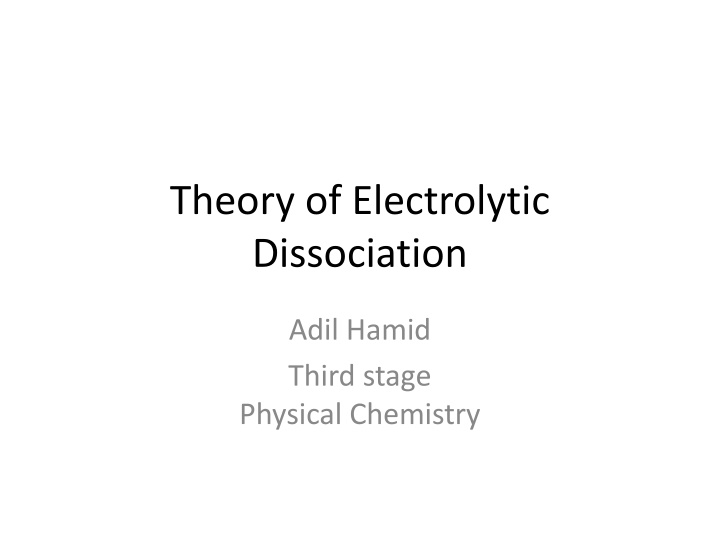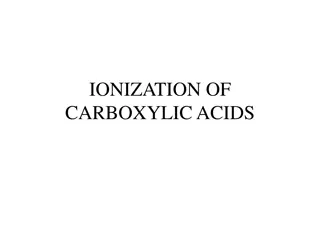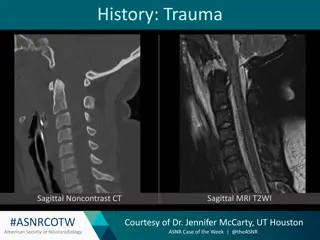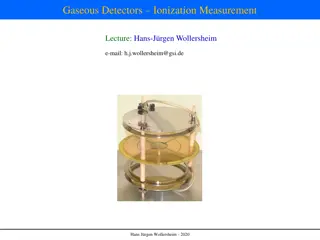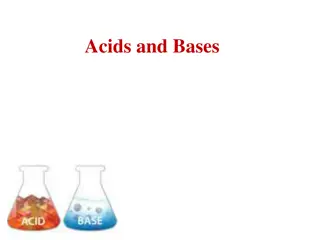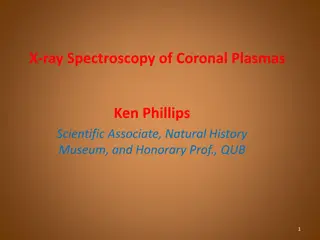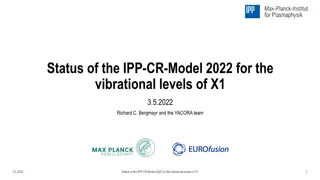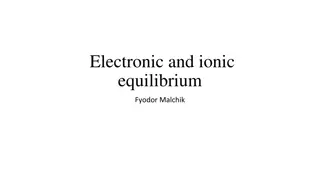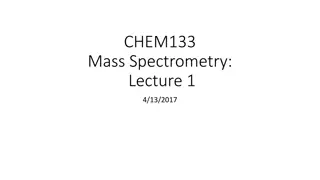Theories of Electrolytic Dissociation and Ionization in Physical Chemistry
The theories of electrolytic dissociation by Adil Hamid and Arrhenius explain how electrolytes dissociate into ions in solution, leading to electrical conductivity. This process involves the migration of cations and anions towards opposite electrodes, affecting the conductivity of the electrolyte. The Lodge's Moving Boundary Experiment demonstrates this phenomenon using a U-tube apparatus.
Download Presentation

Please find below an Image/Link to download the presentation.
The content on the website is provided AS IS for your information and personal use only. It may not be sold, licensed, or shared on other websites without obtaining consent from the author.If you encounter any issues during the download, it is possible that the publisher has removed the file from their server.
You are allowed to download the files provided on this website for personal or commercial use, subject to the condition that they are used lawfully. All files are the property of their respective owners.
The content on the website is provided AS IS for your information and personal use only. It may not be sold, licensed, or shared on other websites without obtaining consent from the author.
E N D
Presentation Transcript
Theory of Electrolytic Dissociation Adil Hamid Third stage Physical Chemistry
Arrhenius Theory Of Ionisation Arrhenius theory of ionisation may be stated as : 1. When dissolved in water, neutral electrolyte molecules are split up into two types of charged particles. The positively charged particles were called cations and those having negative charge were called anions. The solid electrolyte is held together by electrostatic force. When placed in water, these neutral molecules dissociate to form separate anions and cations. For that reason, this theory may be referred to as the theory of electrolytic dissociations.
2. The ions present in solution constantly reunite to form neutral molecules. Thus there is a state of equilibrium between the undissociated molecules and the ions. AB A++ B Applying the Law of Mass Action to the ionic equilibrium we have, where K is called the Dissociation constant.
3. The charged ions are free to move through the solution to the oppositely charged electrode. This movement of the ions constitutes the electric current through electrolytes. This explains the conductivity of electrolytes as well as the phenomenon of electrolysis. 4. The electrical conductivity of an electrolyte solution depends on the number of ions present in solution. Thus the degree of dissociation of an electrolyte determines whether it is a strong electrolyte or a weak electrolyte.
Migration Of Ions We know that electrolytes dissociate in solution to form positive ions (cations) and negative ions (anions).
As the current is passed between the electrodes of the electrolytic cell, the ions migrate to the opposite electrodes. Thus in the electrolytic solution of AgNO3, the cations (Ag+) will move to the cathode and anions (NO3-) will move to the anode. Usually different ions move with different rates.
The apparatus used consists of a U-tube which has a long horizontal portion. The horizontal portion is filled with a jelly of agar-agar treated with a trace of alkali. This is then made red by addition of a few drops of phenolphthalein. When the jelly is set, dilute sulphuric acid is added in the anodic limb of the tube. Sodium sulphate solution is added in the cathodic limb. On passing the current, H+ ions in the left limb solution eventually move into the agar-agar jelly. Their passage is marked by the gradual discharge of the red colour due to the neutralisation of the alkali by H+ ions. The movement of the red boundary through the agar-agar jelly shows that H+ ions migrate to the cathode limb.
The speeds of cations migrating towards the cathode and those of anions migrating towards the anode are not necessarily the same. The speed of a cation moving away from the anode will be proportional to the fall of concentration of these ions at the anode. Similarly, the speed of an anion moving away from the cathode will be proportional to the fall of concentration of anions around the cathode. Hittorf s Rule states that: the loss of concentration around any electrode is proportional to the speed of the ion moving away from it.
(i) Let the anions alone be capable of movement When, two anions have moved towards the anode, we get the position as shown in II. The cations have not moved at all. But inspite of that the number of discharged anions and cations is the same, 2. The concentration in the anode compartment, however, has not altered while in the cathode compartment it has fallen by two ion-pairs. (ii) Let the anions and cations move at the same rate When two ions of each type have crossed over towards the opposite electrodes, we get the condition as shown in III. The number of discharged anions and cations is the same, 4. The concentration of both the anode compartment and the cathode compartment has fallen to the same extent , by two ion-pairs.
(iii) Let the cations move at twice the speed of the anions In this case, when cations have moved to the cathode compartment, one anion passes into the anode compartment. The state of affairs is shown in IV. The total number of discharged anions and cations is again the same, 3. Although the concentration in the cathode compartment has fallen by one ion-pair, the concentration in the anode compartment decreases by two ion-pairs. It is evident that ions are always discharged in equivalent amounts on the opposite electrodes. Due to the difference in the speeds of anions and cations, we conclude that the loss in concentration around any electrode is proportional to the speed of the ion moving away from it.
Ions are always discharged in equivalent amounts on the opposite electrodes. Loss in concentration around any electrode is proportional to the speed of the ion moving away from it. This is Hittorf s Rule. We can write the expression : In deriving the above relation, an important assumption has been made, namely, the discharged ions do not react with the material of the electrodes. However, in many cases they combine with the material of the electrodes rather than depositing on it. This results in an increase in concentration around such an electrode instead of a decrease.
What Is Transport Number ? During electrolysis the current is carried by the anions and the cations. The fraction of the total current carried by the cation or the anion is termed its Transport number or Hittorf s number. If v+ represents the speed of migration of the cation and v that of the anion,
Determination Of Transport Number There are two methods for determination of the transport number of an ion: (1) Hittorf s method (2) Moving Boundary method
Hittorfs Method According to this rule, the loss of concentration around any electrode is proportional to the speed of the ion moving away from that electrode. The transport number of an ion is calculated from the changes in concentration found experimentally around the electrodes. The apparatus used in this method consists of two vertical glass tubes joined together through a U-tube in the middle. The apparatus is filled with a solution of silver nitrate and a steady current of about 0.01 ampere is passed for two to three hours.
Moving Boundary Method This method is very accurate and has been used in recent years for precision measurements. The apparatus used consists of a long vertical tube fitted with two electrodes at the two ends filled with a solution of cadmium chloride (CdCl2) at the lower end and hydrochloric acid at the upper end in a way that there is a sharp boundary between the two. The platinum cathode dipped in HCl solution is inserted at the top and the anode (cadmium stick) is introduced at the bottom.
On passing electric current through the apparatus, hydrogen gas is evolved at the cathode and H+ ions move toward the anode. The H+ ions are replaced by Cd2+ ions and hence the boundary line moves in the upward direction. By noting the length through which the boundary moves and the quantity of electricity passed through the cell, the transport number of H+ ion can be calculated. In general, if the transport number of a cation A+ is to be determined, the electrolyte AX solution is taken in the upper part of the apparatus and a layer of another electrolyte BX having the common ion X is introduced in the lower part of the apparatus. The electrolyte BX is selected so that the velocity of B+ ion is less than that of A+ ion.
Kohlrauschs Law From a study of the equivalent conductance at infinite dilution ( ), Kohlrausch discovered that each ion contributes to the conductance of the solution. Kohlrausch s Law states that: the equivalent conductance of an electrolyte at infinite dilution is equal to the sum of the equivalent conductance of the component ions. = a + c where a is the equivalent conductance of the anion and c that of the cation.
For example, the equivalent conductance of NaCl at infinite dilution at 25 C is found to be 126.45. The equivalent conductance of Na+ and Cl ion is 50.11 ohm 1 and 76.34 ohm 1 respectively. Thus,
(1) Calculation of for Weak electrolytes Weak electrolytes do not ionize completely even at very great dilution so the practical determination of is not possible. However, it can be calculated with the help of Kohlrausch s law. Thus the ionic conductance of an ion is obtained by multiplying the equivalent conductance at infinite dilution of any strong electrolyte containing that ion by its transport number. In this manner, the ionic mobilities of the two ions present in the weak electrolyte can be calculated. Thus we can get the equivalent conductance of the electrolyte at infinite dilution by adding up these two values.
(2) Calculation of Absolute Ionic mobilities The absolute ionic mobility of an ion is defined as the velocity of an ion in centimetre per second under a potential gradient of one volt per centimetre. (Potential gradient = applied EMF/distance between (the electrodes). It is expressed in cm sec 1. For example, let the velocity of the ion at infinite dilution be U cm per second when the distance between the electrodes is 20 cm and the voltage 100 V. Then the potential difference is 100/20 i.e., 5 volts per cm and the ionic mobility is U/5 cm sec 1.
(3) Calculation of the solubility of sparingly soluble salts Substance like AgCl or PbSO4 which are ordinarily called insoluble do possess a definite value of solubility in water. This can be determined from conductance measurements of their saturated solutions. Since a very small amount of solute is present it must be completely dissociated into ions even in a saturated solution so that the equivalent conductance V is equal to equivalent conductance at infinite dilution. This according to Kohlrausch s Law is the sum of the ionic mobilities. V = = a + c knowing and , V can be found out which is the volume in ml containing 1 g-eqvt of the electrolyte.
(4) Calculation of the Degree of Dissociation or Conductance Ratio The apparent degree of dissociation, , of an electrolyte at the dilution V is given by = v / , where v is the equivalent conductance of the electrolyte at the dilution V and is its equivalent conductance at infinite dilution. This according to Kohlrausch s Law is the sum of a and c.
(5) Calculation of the Ionic product for Water The observed specific conductance of water at 25 C is 5.54 10 8 mhos. The conductance of one litre of water containing 1 g-eqvt of it would be: H2O= 5.54 10 8 1000 = 5.54 10 5mhos At the same temperature the conductance of H+ ions and OH ions are: H+ = 349.8 mhos OH-= 198.5 mhos According to Kohlrausch s Law H2O= H++ OH = 349.8 + 198.5 = 548.3 mhos One molecule of water gives one H+ ion and one OH ion, assuming that ionic concentration is proportional to conductance, we have,
Conductometric Titrations Conductometric titrations are used for determining the end- point of acid-alkali reactions and precipitation reactions. In these titrations, advantage is taken of the fact that the conductance of a solution at a constant temperature depends upon the number of ions present in it and their mobility. For this purpose, the titrant is added from a burette into a measured volume of the solution to be titrated which is taken in a conductance cell and the conductance readings corresponding to the various additions are plotted against the volume of the titrant. In this way two linear curves are obtained, the point of intersection of which is the end-point.
Advantage of Conductometric Titrations (1) Coloured solutions where no indicator is found to work satisfactorily can be successfully titrated by this method. (2) This method is useful for the titration of weak acids against weak bases which do not give a sharp change of colour with indicators in ordinary volumetric analysis. (3) More accurate results are obtained because the end -point is determined graphically. Types of Conductometric titration: (1) Titration of a Strong acid against a Strong base (2) Titration of a Weak acid against a Strong alkali (3) Titration of a Strong acid against a Weak base (4) Titration of a Weak acid against a Weak base (5) Precipitation reactions
(1) Titration of a Strong acid against a Strong base Consider the reaction in which hydrochloric acid solution is titrated against a solution of sodium hydroxide. Take 20 ml of the acid solution in the conductance cell placed in a thermostat and determine its conductance. Now add 1 ml sodium hydroxide solution from the burette at a time. After each addition, determine the conductance of the solution after through mixing and plot the conductance of the solution against the volume of the alkali added.
The point of intersection of the interpolated lines will be the end point. Before the addition of alkali, the conductance of the solution is due to presence of H+ and Cl ions. Since hydrogen ions possess the greatest mobility of any ion, the greater part of the conductance is due to it. As alkali solution is added, the hydrogen ions are removed by combination with the hydroxyl ions forming feebly ionised water molecules and their place is taken up by comparatively slow moving Na+ ions. H++ Cl + Na++ OH Na++ Cl + H2O As a result, the conductance of the solution decreases till the end-point is reached. After the equivalence point, the further addition of sodium hydroxide solution results in an increase of conductance. The point of minimum conductance, therefore, coincides with the end-point of the titration.
(2) Titration of a Weak acid against a Strong alkali CH3COOH + Na+ + OH CH3COO + Na+ + H2O The initial conductance of the solution is low because of the poor dissociation of the weak acid. On adding alkali, sodium acetate is formed and acetate ions at first tend to suppress the ionisation of acetic acid due to Common Ion Effect but after a while the conductance begins to increase. After the end point, further addition of sodium hydroxide introduces the fast moving hydroxyl ions, thus, the conductance value shows a sharp increase. The point of intersection of the two curves, gives the end-point.
(3) Titration of a Strong acid against a Weak base (4) Titration of a Weak acid against a Weak base
(5) Precipitation reactions In this type, the change in conductance on the addition of silver nitrate is not much since the mobility of the potassium ion and the silver ion is of the same order so the curve is nearly horizontal. Ag+ + NO3- + K+ + Cl K+ + NO3- + AgCl (ppt) After the end-point, there is a sharp increase in conductance due to an increase in the number of free ions in solution.
